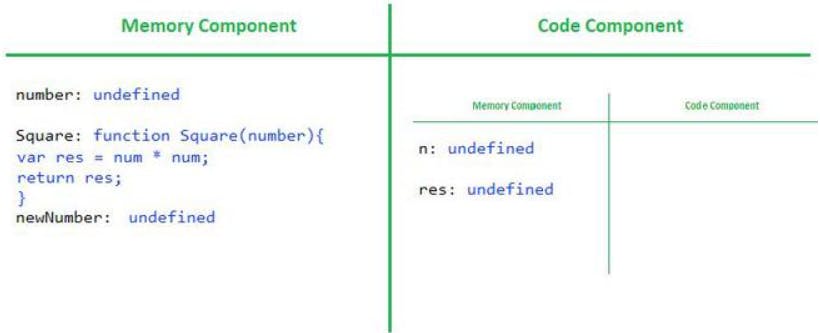Javascript Code Execution
JavaScript is a synchronous (Moves to the next line only when the execution of the current line is completed) and single-threaded (Executes one command at a time in a specific order one after another serially) language. To know behind the scene of how JavaScript code gets executed internally, we have to know something called Execution Context and its role in the execution of JavaScript code.
Execution Context: Everything in JavaScript is wrapped inside Execution Context, which is an abstract concept (can be treated as a container) that holds the whole information about the environment within which the current JavaScript code is being executed.
Now, an Execution Context has two components and JavaScript code gets executed in two phases.
Memory Allocation Phase: In this phase, all the functions and variables of the JavaScript code get stored as a key-value pair inside the memory component of the execution context. In the case of a function, JavaScript copied the whole function into the memory block but in the case of variables, it assigns undefined as a placeholder.
Code Execution Phase: In this phase, the JavaScript code is executed one line at a time inside the Code Component (also known as the Thread of execution) of Execution Context.
Let’s see the whole process through an example.
var number = 2;
function Square (n) {
var res = n * n;
return res;
}
var newNumber = Square(3);
In the above JavaScript code, there are two variables named number and newNumber and one function named Square which is returning the square of the number. So when we run this program, Global Execution Context is created.
So, in the Memory Allocation phase, the memory will be allocated for these variables and functions like this.

In the Code Execution Phase, JavaScript being a single thread language again runs through the code line by line and updates the values of function and variables which are stored in the Memory Allocation Phase in the Memory Component.
So in the code execution phase, whenever a new function is called, a new Execution Context is created. So, every time a function is invoked in the Code Component, a new Execution Context is created inside the previous global execution context.

So again, before the memory allocation is completed in the Memory Component of the new Execution Context. Then, in the Code Execution Phase of the newly created Execution Context, the global Execution Context will look like the following.

As we can see, the values are assigned in the memory component after executing the code line by line, i.e. number: 2, res: 4, newNumber: 4.
After the return statement of the invoked function, the returned value is assigned in place of undefined in the memory allocation of the previous execution context. After returning the value, the new execution context (temporary) gets completely deleted. Whenever the execution encounters the return statement, It gives the control back to the execution context where the function was invoked.

After executing the first function call when we call the function again, JavaScript creates again another temporary context where the same procedure repeats accordingly (memory execution and code execution). In the end, the global execution context gets deleted just like child execution contexts. The whole execution context for the instance of that function will be deleted
Call Stack: When a program starts execution JavaScript pushes the whole program as global context into a stack which is known as Call Stack and continues execution. Whenever JavaScript executes a new context and just follows the same process and pushes to the stack. When the context finishes, JavaScript just pops the top of the stack accordingly.

When JavaScript completes the execution of the entire code, the Global Execution Context gets deleted and popped out from the Call Stack making the Call stack empty.
Thank you for giving your valuable time. Happy Learning !!